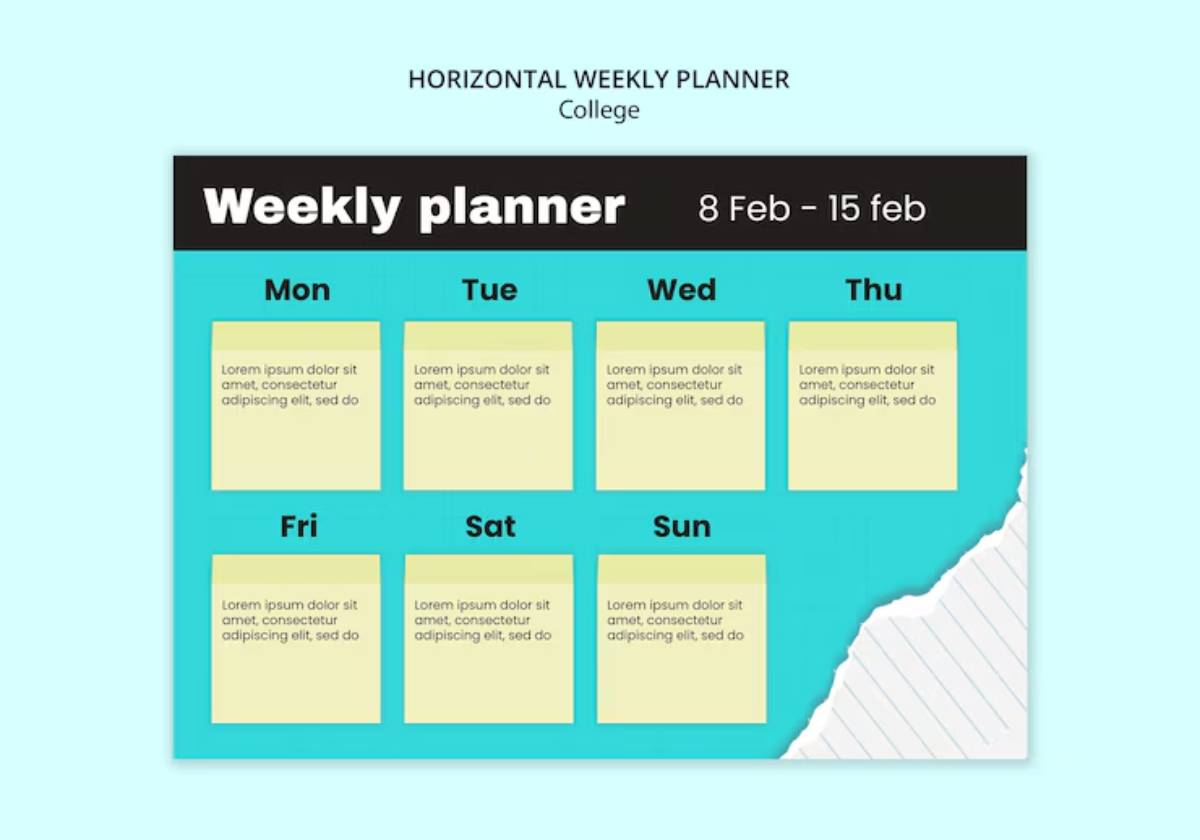
Weekly Scheduling Templates That Actually Work
Are You Winging Your Week? You Deserve Better
Picture this: it’s Wednesday afternoon. You’ve missed a deadline, your lecture notes are scattered, and your brain feels like it’s been in five places at once. You meant to revise, attend a seminar, and go to the gym — but somehow, none of it happened. Sound familiar?
Here’s the good news: your week doesn’t have to feel like a scramble. With the right weekly student schedule, you can plan ahead, stay on top of your classes, and still have time for downtime (yes, even Netflix). The secret? A planner template for students that actually fits your life, not one that overwhelms or over-schedules you.
This guide walks you through building a flexible but effective class week plan, complete with downloadable templates, time-blocking tips, and real-life student-tested routines. Whether you’re trying to pull up your grades, make space for self-care, or just feel a little more in control, this is your starting point.
Why Weekly Planning Works for Students
You Have More Control Than You Think

When you look at your week as a whole, instead of just surviving one day at a time, you can manage your energy and responsibilities more proactively.
Weekly planning helps you:
- Spot busy days in advance
- Distribute study sessions evenly
- Schedule breaks (and stick to them)
- Prevent last-minute stress
According to a 2022 study by Frontiers in Psychology, students who used structured weekly planning showed better academic performance and reported lower stress levels compared to those who used daily-only planning or none at all.
From Chaos to Clarity
A weekly planner acts like a navigation app for your academic life. It helps you see where you’re going, avoid mental traffic jams, and reroute when things shift.
What Makes a Weekly Student Schedule Work?
Not all planners are created equal. A schedule that works for your roommate might leave you exhausted. The trick is to build one that suits your energy, classes, and commitments.
Key Elements of an Effective Class Week Plan:
- Class Times : Fixed commitments like lectures, labs, and seminars
- Study Blocks : Dedicated time for reading, revising, and assignments
- Buffer Time : Space between tasks to handle delays or transitions
- Self-Care : Sleep, meals, movement, mental rest
- Flexibility : Room for change when life inevitably happens
If you’re looking to structure each study session more precisely, an hourly breakdown might offer the clarity you need.
Bonus Tip:
Use themes for different days. For example:
- Mondays = review and prep
- Wednesdays = deep work (essay writing)
- Fridays = lighter admin or creative tasks
Sample Weekly Scheduling Templates (You Can Copy or Adapt)
Let’s explore a few templates suited to different types of student lifestyles.
Template A: The Classic Time-Block Grid (Best for Visual Learners)
Format : Hour-by-hour breakdown for each weekday
Best for : Students who love colour-coding and structure
How to use:
- Start by filling in fixed commitments (classes, job shifts)
- Next, block out study times around your energy peaks
- Then, add meals, exercise, and personal time
Time Monday Tuesday Wednesday Thursday Friday 7–8 AM Wake + breakfast Gym Wake + stretch Read notes Yoga 9–11 AM Lecture Study session Seminar Lecture Deep work 11–1 PM Reading Group work Writing Study Class 1–2 PM Lunch Lunch Lunch Lunch Lunch 2–4 PM Free/Study Lecture Free Revise Library 4–6 PM Gym + rest Study Job shift Break Wrap up 6–8 PM Dinner + chill Social Dinner Catch-up Relax Template B: Priority Planner (Best for Goal-Oriented Students)
Format: Weekly checklist + time slots
Best for: Students who focus on tasks rather than exact timings
Sections Include:
- Top 3 goals of the week
- List of tasks for each course
- Daily highlights (what must get done that day)
- “If I have time” extras
Example: Weekly Goals:
- Finish the psychology essay draft
- Revise chapters 3–5 for the midterm
- Apply for an internship
Daily Highlights:
- Monday : Library research, submit tutorial Qs
- Tuesday : Seminar, plan essay structure
- Wednesday : Revise psych theories, flashcards
- Thursday : Finish essay intro, gym
- Friday : Proofread essay, email professor
Template C: Digital-First Planner (Best for Tech-Savvy Students)

Format : Google Calendar, Notion, or Trello
Best for : Students who live on their devices
Features to build in:
- Time-blocked calendar views
- Clickable task lists
- Reminder notifications
- Colour-coded labels (e.g. blue = study, red = deadlines, green = self-care)
Real-World Example : Priya, a computer science student, uses Google Calendar synced with Notion. She plans her week every Sunday night and links relevant docs to each time block.
“When a notification pops up saying ‘Start finalising design report,’ I know exactly what I’m doing — no wasted time.”
How to Build Your Own Weekly Class Schedule
Even the best templates need to be tailored. Here’s a step-by-step to build your custom schedule:
1: List All Fixed Events
Start with non-negotiables: classes, job shifts, club meetings. These anchor your week.
2: Identify Study Priorities
What’s due soon? What’s difficult? Which subjects need more time? Allocate study blocks accordingly.
3: Time Segment Your Day
Use natural rhythm zones:
- Morning : high-focus tasks like problem-solving
- Afternoon : collaborative or creative work
- Evening : admin or light reading
4: Include Rest and Flex Blocks
Add buffers between sessions. Plan breaks as you would plan study time.
5: Review and Adjust Weekly
Each Sunday, reflect: What worked? What didn’t? Then tweak accordingly.
Real Student Stories: How Weekly Planning Helped
Adeel – Engineering Student
Adeel was constantly missing deadlines and feeling burnt out. Once he implemented a time-block grid, he found it easier to balance lab work with study and recovery.
“It gave me breathing room and made sure I wasn’t just reacting to whatever felt urgent.”
Mia – English Literature Student
Mia uses a priority planner. She sets three weekly goals and schedules 1–2 key tasks a day. No back-to-back marathons, just steady progress.
“The mental load has dropped. I actually enjoy my study sessions now because they’re purposeful, not rushed.”
Mistakes to Avoid With Weekly Scheduling
- Overfilling your schedule : Leave space. If your plan doesn’t allow for the unexpected, it won’t last.
- Copying others blindly : What works for a morning person might not work for a night owl.
- Ignoring review time : Always schedule short sessions to revisit notes, not just new tasks.
- Letting it get too rigid : A plan should help, not trap you. Flexibility = sustainability.
Tools and Templates to Get You Started
Looking for downloadable templates? Try these:
- Canva : Free printable student planners (search “weekly student planner”)
- Notion : Pre-built “Student Dashboard” templates
- Google Sheets : Customisable time-blocked calendars
- Trello : Drag-and-drop boards for weekly task organisation
You can also create your plan digitally with tools like Google Calendar to simplify your weekly overview.
Conclusion: Your Week, Your Way
Here’s the truth: you don’t need to be “naturally organised” to take charge of your schedule. With the right weekly student schedule and a template that fits your rhythm, you can stop firefighting and start planning ahead — with clarity, purpose, and space to breathe.
Whether you love digital dashboards, sticky notes, or simple lists, there’s a planner template for students out there that can work wonders for your focus and well-being. It’s not about packing your week — it’s about designing it with intention.
So take 30 minutes this Sunday. Map out your week. Try a new layout. Test it for a week or two. You’ll be surprised how much calmer, clearer, and more capable you’ll feel.
What kind of weekly planner works best for you — digital or paper? Drop your answer in the comments below, and if you want a free copy of my favourite class week plan layout, just say the word.
And if this helped you feel more in control of your study life, share it with a friend who could use a planning reset!


